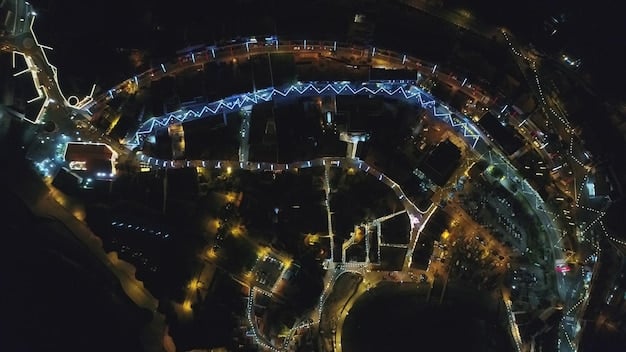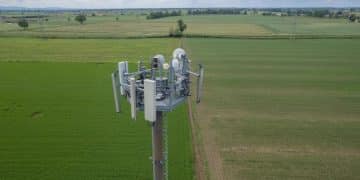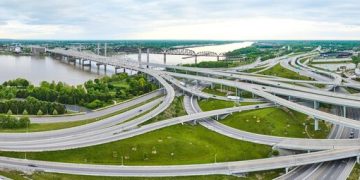US Smart City Initiatives: IoT Boosting Urban Infrastructure & Sustainability

US smart city initiatives are leveraging the power of the Internet of Things (IoT) to revolutionize urban infrastructure, creating more efficient, sustainable, and livable environments for citizens through real-time data collection and adaptive management systems.
The concept of a US Smart City Initiatives: Improving Infrastructure and Sustainability with IoT is rapidly transforming how urban centers function across the United States. These innovative approaches promise a future where technology and urban living seamlessly intertwine, enhancing efficiency, resilience, and the overall quality of life.
The Dawn of Smart Cities: A Transformative Vision
The vision for smart cities in the United States extends beyond mere technological upgrades; it is about fundamentally re-imagining urban ecosystems to address complex challenges like traffic congestion, energy consumption, and environmental degradation. This holistic approach integrates advanced technologies to create more responsive and adaptable urban environments.
At its core, a smart city harnesses real-time data and interconnected systems to make informed decisions, optimizing resource allocation and improving service delivery. The underlying philosophy is to build cities that are not just “wired,” but truly intelligent, capable of learning and evolving.
Defining the Smart City Paradigm
A smart city can be broadly defined as an urban area that uses various types of electronic methods and sensors to collect data. Insights gained from that data are used to manage assets, resources, and services efficiently. In return, the data helps improve operations across the city.
- Connectivity: Establishing a ubiquitous network fabric that allows devices to communicate seamlessly.
- Data Analytics: Processing vast amounts of data to derive actionable insights and predictive models.
- Citizen Engagement: Empowering residents through digital platforms and responsive urban services.
- Sustainability Focus: Prioritizing green initiatives and resource conservation through technological means.
The paradigm shift represented by smart cities moves away from siloed urban management towards an integrated, data-driven framework. This framework emphasizes interdepartmental collaboration and the use of technology to foster a symbiotic relationship between urban infrastructure and its inhabitants.
IoT at the Core: Powering Smart Urban Infrastructure
The Internet of Things (IoT) is arguably the most crucial technological catalyst for smart cities. IoT devices, ranging from tiny sensors to complex integrated systems, serve as the nervous system of the smart city, perpetually collecting and transmitting data from diverse urban elements.
This massive influx of granular data provides an unprecedented level of insight into urban operations, allowing city planners and administrators to monitor, analyze, and react in real-time. Without IoT, the ambitious goals of smart city initiatives would remain largely theoretical.
From Sensors to Solutions: IoT’s Impact
IoT deployment impacts nearly every facet of urban infrastructure. For instance, smart traffic lights embedded with sensors can dynamically adjust signal timings based on real-time traffic flow, mitigating congestion and reducing commute times. Similarly, connected smart streetlights can dim or brighten based on ambient light and pedestrian presence, conserving energy while enhancing safety.
Waste management systems utilize IoT-enabled bins that signal when they are full, optimizing collection routes and reducing fuel consumption. Water management benefits from smart meters and leak detection sensors, minimizing waste and ensuring equitable distribution. These are just a few examples of how IoT translates raw data into tangible operational improvements.
Key IoT Applications in Smart Infrastructure
- Smart Transportation: Traffic flow optimization, intelligent parking systems, public transit tracking, and autonomous vehicle integration.
- Smart Energy Grids: Real-time consumption monitoring, demand-response programs, and renewable energy integration.
- Smart Waste Management: Sensor-enabled bins, optimized collection routes, and recycling incentive programs.
- Smart Water Systems: Leak detection, pressure monitoring, and optimized irrigation for public spaces.
The transformative power of IoT lies in its ability to connect the physical and digital worlds, creating a seamless flow of information that makes urban infrastructure not just responsive, but predictive. This foresight allows cities to anticipate issues before they escalate, enhancing resilience and operational efficiency.
Enhancing Sustainability Through Smart City Technologies
A driving force behind many US smart city initiatives is the imperative for environmental sustainability. Cities are major contributors to carbon emissions and resource consumption, and smart technologies offer powerful tools to mitigate these impacts, fostering greener and more resilient urban environments.
Sustainability in smart cities is not just about reducing carbon footprints; it encompasses efficient resource management, waste reduction, pollution control, and fostering a healthier living environment for citizens. IoT plays a pivotal role in achieving these objectives by providing the data and automation needed for effective conservation efforts.

Resource Optimization and Pollution Control
Smart energy grids, for example, can integrate renewable energy sources more effectively, balance demand fluctuations, and minimize energy waste through real-time monitoring and automation. Smart lighting reduces energy consumption by adapting to conditions, ensuring light is only provided when and where it is needed.
Beyond energy, smart waste management systems significantly reduce the environmental burden of urban refuse. By optimizing collection routes and providing timely data on bin fill levels, cities lower fuel consumption and emissions from waste collection vehicles. Sensor networks also monitor air and water quality, providing crucial data for pollution control measures and public health advisories.
Promoting Greener Urban Living
Smart city initiatives also promote sustainable living practices among residents. Digital platforms can encourage carpooling, public transit usage, and cycling by providing real-time data on transport options and incentives. Smart irrigation systems in parks and public spaces conserve water by adjusting watering schedules based on hyper-local weather data and soil moisture levels.
Ultimately, smart city technologies empower cities to move beyond reactive environmental management to a proactive and preventative approach. This fosters a future where urban development and ecological preservation are not competing objectives, but rather complementary facets of a thriving, sustainable metropolis.
Key US Smart City Initiatives and Case Studies
Across the United States, numerous cities are leading the charge in smart city development, implementing innovative IoT solutions to tackle unique urban challenges and improve citizen welfare. These initiatives serve as blueprints for other municipalities, showcasing the tangible benefits of a data-driven urban strategy.
From the East Coast to the West, cities are investing in smart infrastructure, demonstrating a commitment to modernization and sustainability. Each case study offers valuable lessons regarding implementation, challenges, and successes in integrating IoT into complex urban environments.
Examples of Pioneering Cities
Columbus, Ohio: Winner of the USDOT Smart City Challenge, Columbus received significant funding to develop an integrated smart mobility ecosystem. This includes connected vehicle technology, smart traffic signals, public transit improvements, and autonomous vehicle shuttles aimed at improving access and reducing congestion.
Kansas City, Missouri: Implemented a smart streetlight network along its historic streetcar line, incorporating Wi-Fi kiosks, smart LED lighting, and video sensors for public safety and waste management. This initiative has significantly improved public services and efficiency.
San Diego, California: Boasts one of the world’s largest smart city platforms, utilizing over 3,200 smart sensors on streetlights for environmental monitoring, parking availability, and pedestrian safety. The data collected informs urban planning and resource management, promoting sustainability across the city.
Lessons from Implementation
These initiatives highlight several common themes. Firstly, successful smart city projects often begin with a clear problem statement and measurable objectives. Secondly, public-private partnerships are crucial for securing funding, expertise, and technological solutions. Thirdly, citizen buy-in and engagement are vital for the long-term success and adoption of smart technologies.
Moreover, these case studies underline the importance of scalability and interoperability. Solutions developed for one urban challenge often have applications in other areas, making modular and open-standard technologies preferable. The ongoing evolution of these projects provides invaluable insights into the practicalities of urban technological transformation.
Challenges and Opportunities in Smart City Development
While the promise of smart cities is immense, their development is not without significant hurdles. Overcoming these challenges is crucial for unlocking the full potential of IoT-driven urban transformation. However, these challenges also present unique opportunities for innovation and collaboration.
Navigating the complex landscape of policy, funding, data privacy, and technological integration requires careful planning, strategic partnerships, and a forward-thinking approach from city leaders and technology providers alike.
Addressing Key Obstacles
One primary challenge is funding. Implementing large-scale smart city initiatives requires substantial investment, often necessitating diverse funding models including federal grants, public-private partnerships, and innovative financing. Another significant hurdle is data security and privacy. The vast amounts of personal and operational data collected by IoT devices raise concerns about surveillance, hacking, and data misuse, demanding robust cybersecurity protocols and transparent data governance policies.
Interoperability is also a critical challenge. Different IoT devices and platforms often operate on proprietary standards, leading to siloed data and inefficient integration. Developing open standards and common platforms is essential for creating truly interconnected urban ecosystems.
Seizing Future Opportunities
- Economic Development: Smart city initiatives can attract tech companies, create new jobs, and foster a vibrant innovation ecosystem.
- Citizen Engagement: Enhanced digital services and transparent data can improve civic participation and trust in local government.
- Resilience Building: Smart infrastructure can make cities more resilient to climate change, natural disasters, and other unforeseen events.
- Improved Quality of Life: Reduced commutes, cleaner environments, and safer public spaces directly translate to higher citizen satisfaction.
Addressing these challenges requires a multi-faceted approach involving policy innovation, technological breakthroughs, and sustained public engagement. The opportunities, however, far outweigh the obstacles, promising a future of more efficient, sustainable, and livable cities for all residents.
Future Trends and the Evolution of US Smart Cities
The trajectory of US smart cities is one of continuous innovation and adaptation. As technology evolves and urban challenges shift, the definition and implementation of smart initiatives will also transform, embracing new paradigms and pushing the boundaries of what’s possible in urban living. Looking ahead, several key trends are poised to shape the next generation of smart cities.
These future trends highlight a growing sophistication in how cities leverage technology, moving towards more autonomous, equitable, and human-centric urban environments. The emphasis will increasingly be on proactive, rather than reactive, urban management.

Emerging Technologies and Their Impact
Artificial Intelligence (AI) and Machine Learning (ML) will become even more integral, moving beyond data analysis to predictive maintenance, autonomous decision-making, and highly personalized urban services. 5G connectivity will provide the necessary bandwidth and low latency for sophisticated IoT applications, enabling real-time responses for critical infrastructure and autonomous systems.
The concept of “digital twins” – virtual replicas of physical assets and urban environments – will become prevalent, allowing city planners to simulate interventions and optimize designs before physical implementation. Furthermore, the integration of blockchain technology could enhance data security and transparency, fostering greater trust in smart city platforms.
Towards Collaborative and Equitable Urban Futures
Future smart cities will likely place a stronger emphasis on social equity and inclusion, ensuring that technological advancements benefit all residents, regardless of socioeconomic status. This involves focused efforts on broadband accessibility, digital literacy programs, and smart solutions that address the needs of underserved communities.
Increased collaboration between cities, universities, private sector innovators, and citizens will be paramount. Open data initiatives and citizen co-creation models will empower residents to actively participate in shaping their urban future. The evolution of US smart cities will be a testament to collective foresight, adaptability, and a shared commitment to building better urban environments.
| Key Aspect | Brief Description |
|---|---|
| 💡 IoT Integration | Sensors and connected devices form the backbone, collecting real-time data for optimized urban services. |
| ♻️ Sustainability Driver | Smart tech reduces energy, water consumption, and pollution, fostering greener urban environments. |
| 🚧 Infrastructure Reboot | Modernizing transport, utilities, and waste management for enhanced efficiency and resilience. |
| 🤝 Collaborative Future | Success relies on partnerships, citizen engagement, and addressing equity and data privacy concerns. |
Frequently Asked Questions About US Smart Cities
▼
A smart city is an urban area that uses technology, especially the Internet of Things (IoT), to collect data and manage assets, resources, and services efficiently. The goal is to improve urban operations, enhance the quality of life for residents, and address environmental challenges through data-driven decisions and interconnected systems.
▼
IoT devices provide the foundational layer for smart cities by enabling real-time data collection from various urban elements like traffic lights, waste bins, and public transport. This data is critical for monitoring, analyzing, and automating urban services, leading to more efficient resource management and improved public safety.
▼
Smart city initiatives boost sustainability by optimizing energy and water consumption through smart grids and irrigation systems. They also help reduce pollution via smart waste management and air quality monitoring. These efforts contribute to a smaller carbon footprint and a healthier urban environment, promoting long-term ecological balance.
▼
US cities encounter challenges such as securing substantial funding for large-scale projects, ensuring robust data security and privacy protocols, and achieving interoperability between diverse technological platforms. Overcoming these requires innovative financing, strong cybersecurity, and the adoption of open standards for seamless data flow.
▼
Future smart cities will likely integrate more advanced AI and ML for predictive capabilities and autonomous operations. They will also emphasize social equity, widespread 5G connectivity, and digital twin technology for urban planning. These advancements aim for more inclusive, resilient, and responsive urban environments that adapt to citizen needs.
Conclusion
The journey towards smarter cities in the US, propelled by the pervasive influence of IoT, signifies a profound evolution in urban management and quality of life. These initiatives are not merely about deploying new gadgets; they represent a fundamental reimagining of how urban infrastructure can be optimized for efficiency, resilience, and sustainability. While the path ahead presents its share of technical, financial, and ethical challenges, the transformative potential of data-driven urbanism remains compelling. As more cities embrace these innovations, we can anticipate a future where urban centers are not just places of residence and commerce, but intelligent ecosystems that actively contribute to the well-being of their inhabitants and the planet.





